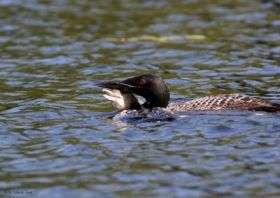Scientists find mercury threatens next generation of loons

A long-term study by the Wildlife Conservation Society, the BioDiversity Research Institute, and other organizations has found and confirmed that environmental mercury—much of which comes from human-generated emissions—is impacting both the health and reproductive success of common loons in the Northeast.
The results of the 18-year study on loons—a species symbolic of northern lakes and wilderness—appear in the most recent edition of Ecotoxicology.
“This study demonstrates how top predators such as common loons can be used as the proverbial ‘canaries-in-the-coalmine’ for pollutants that concern humans as well,” said David C. Evers of the BioDiversity Research Institute and lead author of the study. “Our findings can be used to facilitate national and global decisions for regulating mercury emissions from coal-burning plants and other sources.”
The study uses data from nearly 5,500 samples of blood, feathers, and eggs collected from captured and released loons from some 80 lakes in Maine, New York, New Hampshire, and other states and provinces. The researchers made correlations between the behaviors of individual birds and their levels of methylmercury, the most toxic form of mercury that accumulates up the food chain.
Loons with high levels of mercury—about 16 percent of the adult population in the study area—were found to spend some 14 percent less time at the nest than normally behaving birds. Unattended nests have a higher rate of failure due to either chilling of the eggs or predation by minks, otters, raccoons and other egg robbers.
With behavioral observations from 1,529 loon territories between 1996 and 2005, researchers found that loon pairs with elevated mercury levels also produced 41 percent fewer fledged young than loons in lakes relatively free of mercury. Other behavioral impacts due to elevated mercury were sluggishness, resulting in decreased foraging for fish by the adults for both themselves and for chicks.
In addition to behavior, the concentration of mercury in loons has physiological impacts as well.
“This study confirms what we’ve long suspected—mercury from human activities such as coal-burning power plants—is having a significant negative impact on the environment and the health of its most charismatic denizens, and potentially, to humans, too,” said Nina Schoch of the Wildlife Conservation Society’s Adirondack Program. “Thus, it becomes even more urgent for the EPA to propose effective national regulations for mercury emissions from power plants that are based on sound science.”
Although many northeastern states have implemented stringent mercury emission rules, a nationwide regulation has yet to be passed. The U.S. District Court of Appeals recently struck down the EPA’s proposed Cap-and-Trade Rule for mercury emissions from coal-fired power plants, which would have led to localized “hotspots” of mercury, a highly toxic pollutant. “The ecological impacts of mercury identified in this study illustrate the need for comprehensive, national regulations to limit mercury emissions,” added Schoch.
Source: Wildlife Conservation Society















